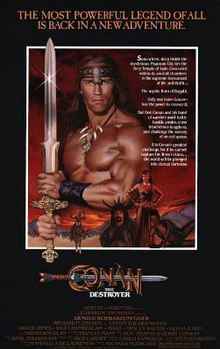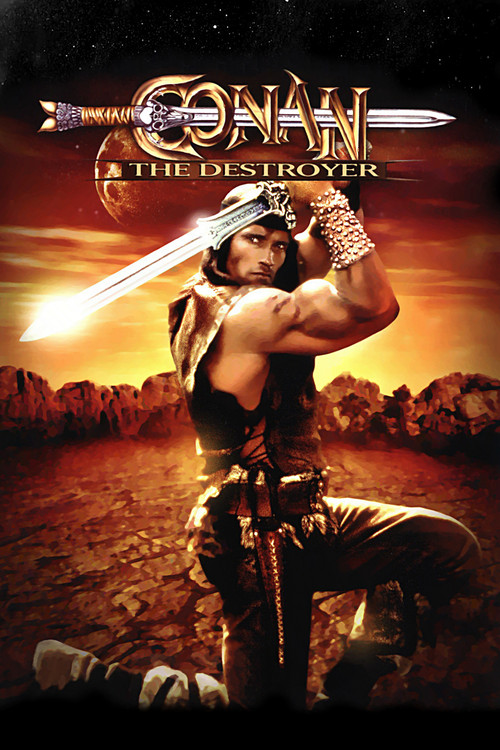Conan the Destroyer is a 1984 American sword and sorcery/adventure film directed by Richard Fleischer, starring Arnold Schwarzenegger and Mako Iwamatsu reprising their roles as Conan and Akiro the wizard, respectively. The cast also includes Grace Jones, Wilt Chamberlain, Tracey Walter and Olivia d'Abo. It is the sequel to Conan the Barbarian. The film was moderately successful at the box office in the U.S., and very successful internationally, although critical response was not as strong as for the original film.
Plot

While praying at an altar with his traveling companion and fellow thief Malak (Tracey Walter), Conan (Arnold Schwarzenegger) is confronted by Queen Taramis (Sarah Douglas) of Shadizar, who tests the pair in combat with several of her guards. She tells him that she has a quest for him, but he initially refuses her until she uses her power to learn his greatest desire: his beloved Valeria. Promised Valeria's resurrection, Conan agrees to the quest which is to escort the Queen's niece, Jehnna (Olivia d'Abo), who destined to find a special jewel that can be used to obtain the jeweled horn of the dreaming god Dagoth. Conan and Malak are joined by captain of Taramis's guard Bombaata (Wilt Chamberlain), who is instructed to kill Conan once the jewel is obtained. Because the gem is secured in the fortress of a powerful wizard, Conan seeks the help Akiro (Mako), the Wizard of the Mounds who aided him before. After saving Akiro from a tribe of cannibals who plan to eat him to absorb his magic, Conan's group encounter Zula (Grace Jones), a powerful warrior and bandit being tortured by vengeful villagers. Freeing Zula at Jehnna's request, Conan accepts the indebted warrior's offer to join their quest.
Conan's group eventually reaches the icy castle of Toth-Amon (Pat Roach) where the jewel is located, the wizard kidnaps Jehnna in the dead of night in the form of a bird of smoke. The company ventures into the castle, Conan mortally wounding the wizard after defeating his magical creature. But Toth-Amon's death ends the magic binding the castle together, forcing the group's hasty retreat before being ambushed by Taramis's guards. Conan defeats the guard abducting Jehnna while Bombaata feigns ignorance. As the group head to where the jeweled horn of Dagoth is hidden, Jehnna expresses romantic interest in Conan, but he drunkenly rebuffs her and declares his devotion to Valeria. Once at the temple, as Jehnna obtains the horn, Akiro deciphers ancient writing that the horn will awaken Dagoth from his sleep and that Jehnna will be sacrificed as part of the ritual. Fighting the guardians of the horn, the group manage to find a secret exit passage before Bombaata blocks their exit while seizing Jehnna. Realizing he had been tricked, Conan and his allies make for Shadizar to save Jehnna as she is drugged and prepared to be sacrificed as the horn is placed in the stone body of Dagoth.
After using a secret route known to Malak (through his "Cousin's sister's brother", basically his first cousin) to reach the throne room, Conan defeats Bombaata in combat while Zula impales the Grand Vizier (Jeff Corey) as he was about to kill Jehnna. Having received an improper sacrifice as his form distorts into a monstrous entity, Dagoth (André the Giant) kills Taramis while attacking Conan. Eventually, Conan manages to rip Dagoth's horn off to weaken the demonic deity enough to kill him. Soon after, the newly crowned Queen Jehnna offers each of her companions a place in her new court: Zula as new captain of the guard, Akiro as the queen's advisor, and Malak's qualified for the position of court jester. Though Jehnna offers him her hand and the opportunity to rule the kingdom together, Conan declines as he had been promised a kingdom already as he departs on his own for further adventures and to find his own place in the world.
Cast

Production

Toning down the violence
When John Milius, director of Conan the Barbarian, proved to be unavailable to direct the sequel, Dino De Laurentiis suggested Richard Fleischer to his daughter Raffaella De Laurentiis, who was producing Conan the Destroyer. Fleischer had already made Barabbas (1961) and Mandingo (1975) for Dino De Laurentiis.
Conan the Barbarian made approximately $40 million at the U.S. box office when it was released in 1982 with an R rating, and an additional $50 million in foreign markets. Because Universal Pictures and producer Dino De Laurentiis thought it would have been even more successful if it had been less violent, they wanted to tone down the violence in the sequel. Conan the Destroyer originally received an R rating like its predecessor, but the film was recut in order to secure a PG rating. Fleischer delivered a movie that was less violent and somewhat more humorous than the first, although some scenes of violence have bloody results.
Casting
Arnold Schwarzenegger, with the help of Will Hatty, put on an extra 5 kilograms (10 pounds), at director Richard Fleischer's request, to play Conan in this film. Mako Iwamatsu, who played the Wizard of the Mound and narrator in the first film, also returns with his character properly named. Sven-Ole Thorsen, who played Thorgrim in the first film, also returned, but this time he had to partially cover his face with a mask, as he was playing a different (yet more bearded) character. Singer Grace Jones gave a noteworthy performance as the female warrior Zula, the last of her tribe. This would be the first major role for seven-foot, one-inch-tall basketball player Wilt Chamberlain. It would be 15-year-old (at time of release) Olivia d'Abo's first screen appearance, playing the petulant teenage princess. David L. Lander was originally cast to play the foolish thief Malak, but due to Lander's deteriorating health from the onset of multiple sclerosis, Lander was forced to quit the project, and the part was recast with Tracey Walter. André the Giant played Dagoth but was not credited in the film, as he was in costume.
Photography
Conan the Destroyer was the fourth film on which British director of photography Jack Cardiff worked with Fleischer. Cardiff had already photographed The Vikings (1958), Crossed Swords (1977), and Amityville 3-D (1983) for the director. They would work together twice more on Million Dollar Mystery (1987), and Fleischer’s last film, the short Call from Space (1989), which was shot in the 65mm Showscan process. Cardiff’s other notable films include John Huston’s The African Queen (1951), King Vidor’s War and Peace (1956), and Rambo: First Blood Part II (1985). However, he is best known for his extraordinary Technicolor photography on three films directed by Michael Powell and Emeric Pressburger in the forties â€" A Matter of Life and Death (1946), Black Narcissus (1947, for which Cardiff won an Oscar), and The Red Shoes (1948).
Locations
Conan the Destroyer was filmed in a number of locations in Mexico â€" including Pachuca, the extinct volcano Nevado de Toluca, and the Samalayuca Dunes (near to Ciudad Juárez and El Paso) â€" as well as in the Churubusco Studios (also in Mexico). Carlo Rambaldi created the Dagoth monster.
Deleted scenes
In the film, a camel is knocked to the ground and, after struggling to get back up, its hind legs are drawn forward with wires so that it is forced to sit down before falling to the ground. This sequence is cut from the U.K. version, as is a double horse-fall in the opening battle. There are a number of deleted scenes from the movie confirmed by actress Sarah Douglas including; Conan and Queen Taramis love scene, Taramis slapping Bombatta, extended battle scene between Conan and the Man-ape, and more graphic action scenes.
Music

The musical score of Conan The Destroyer was composed, conducted and produced by Basil Poledouris, and it was performed by The Orchestra "Unione Musicisti Di Roma".
Soundtrack

Track Listing for the First Release on LP
Side One
- Main Title / Riders Of Taramis 3:31
- Valeria Remembered 3:02
- The Horn Of Dagoth 2:17
- Elite Guard Attacks 2:23
- Crystal Palace 6:00
Side Two
- The Katta 1:05
- Dream Quest 1:30
- Night Bird 2:21
- Approach To Shadizaar 2:40
- The Scrolls Of Skelos 2:26
- Dueling Wizards 1:25
- Illusion's Lake 1:27
- Conan & Bombaata Battle 1:16
Track Listing for the First Release on CD
- Main Title / Riders Of Taramis 3:31
- Valeria Remembered 3:02
- The Horn Of Dagoth 2:17
- Elite Guard Attacks 2:23
- Crystal Palace 6:00
- The Katta 1:05
- Dream Quest 1:30
- Night Bird 2:21
- Approach To Shadizaar 2:40
- The Scrolls Of Skelos 2:26
- Dueling Wizards 1:25
- Illusion's Lake 1:27
- Conan & Bombaata Battle 1:16
Reception

Conan the Destroyer received mixed to negative reviews from critics. Despite some lukewarm critical response, the film succeeded at the box-office upon its 1984 release, grossing a respectable $31,042,035 in the U.S. and an additional $69 million in international markets, with the film grossing a combined total of $100,042,035. This success led Schwarzenegger, Fleischer, and De Laurentiis to team up again to make Red Sonja a year later; however, Red Sonja was a critical and commercial disappointment and ended Schwarzenegger's involvement in sword-and-sorcery films. The film was nominated for two Razzie Awards, including Worst Supporting Actress and won Worst New Star for D'Abo.
Marvel Comics published a comic-book adaptation of the film by writer Michael Fleisher and artist John Buscema in Marvel Super Special #35 (Dec. 1984). The adaptation was also available as a two-issue limited series.
Roy Thomas and Gerry Conway wrote the original story treatment, but were dissastified with the final screenplay by Stanley Mann and the finished film. They made their story into the graphic novel Conan the Barbarian: The Horn of Azoth, published in 1990, with art by Mike Docherty. The names of the characters were changed to distance the graphic novel from the movie: Dagoth became Azoth, Jehnna became Natari, Zula became Shumballa, Bombaata became Strabo, Toth-Amon became Rammon, and the characters of Queen Taramis and The Leader were combined into sorcerer Karanthes, father of Natari.
Robert Jordan wrote a novelization of the film in 1984 for Tor.
Conan the Conqueror

The third film in the Conan trilogy had been planned for a 1987 release with the title Conan the Conqueror. The director was to have been either Guy Hamilton or John Guillermin. Arnold Schwarzenegger, however, was committed to the film Predator, and De Laurentiis's contract with the star had expired after his obligation to Red Sonja and Raw Deal, and he was not keen to negotiate a new one. The third Conan film thus sank into development hell. The script was eventually turned into Kull the Conqueror.
In popular culture

Kim Wayans' spoof portrayals of Grace Jones on the show In Living Color are based on Grace's performance of Zula in this film. In 1985 Australian heavy metal music group Prowler changed its name to Taramis after the character from this film.
References

External links

- Conan the Destroyer at the Internet Movie Database
- Conan the Destroyer at AllMovie
- Conan the Destroyer at Rotten Tomatoes
- Conan the Destroyer at Box Office Mojo
